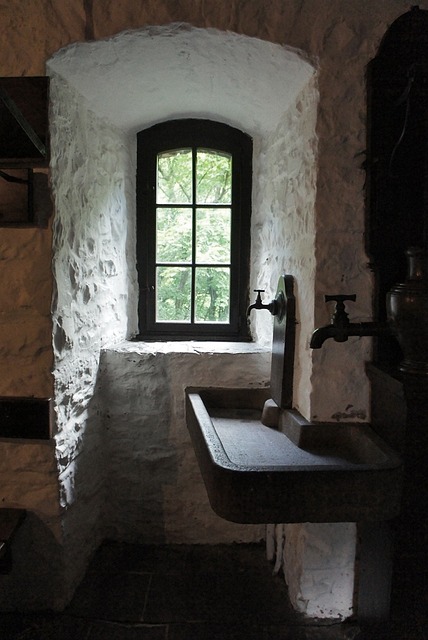Water-resistant flooring, like ceramic bathroom tiles, is crucial for successful bathroom renovations, protecting against moisture and preventing damage. Ceramic tiles, made from fired clay, offer superior water resistance and durability due to their non-porous surface. While vinyl and laminate floors are more flexible and easier to install, ceramic tiles provide a wide range of design options, making them a top choice for renovation projects. Installing ceramic bathroom tiles requires preparation, including underlayment and waterproof membrane application. With regular cleaning and annual grout sealing, these tiles can last decades while maintaining their aesthetic appeal, ensuring both water resistance and low maintenance.
“Transform your bathroom into a sleek, waterproof oasis with the power of ceramic bathroom tiles. This guide unveils the secrets to choosing the perfect water-resistant flooring for your space. Discover how ceramic tiles, renowned for their durability and aesthetic appeal, can withstand moisture while enhancing your interior design. From installation tips to maintenance hacks, learn why these tiles are a top choice for any bathroom renovation. Elevate your space with the timeless elegance of ceramic bathroom tiles.”
- Understanding Water-Resistant Flooring for Bathrooms
- Benefits of Ceramic Bathroom Tiles: Durability and Design
- Installation Tips for Water-Resistant Floorings
- Maintenance and Longevity of Ceramic Bathroom Tiles
Understanding Water-Resistant Flooring for Bathrooms
Water-resistant flooring is an essential consideration when it comes to bathroom renovations, as this type of flooring is designed to withstand high moisture levels and prevent damage. Ceramic bathroom tiles, for example, are a popular choice due to their water-repellent nature and durability. These tiles are made from clay and are fired at high temperatures, creating a hard, non-porous surface that is resistant to water absorption.
When selecting water-resistant flooring, it’s crucial to understand the different options available. Besides ceramic tiles, other materials like vinyl, laminate, and certain types of wood (treated for moisture resistance) can also be suitable. Each material has its advantages and disadvantages in terms of aesthetics, maintenance, and cost. For instance, while ceramic tiles offer excellent water resistance and easy cleaning, they may require more specialized installation compared to vinyl flooring, which is known for its flexibility and ease of fitting around fixtures.
Benefits of Ceramic Bathroom Tiles: Durability and Design
Ceramic bathroom tiles offer a plethora of benefits that make them an excellent choice for any bathroom renovation. One of their standout features is durability; these tiles are designed to withstand high moisture levels, making them ideal for wet environments. They are chip-resistant and easy to clean, ensuring your bathroom stays looking pristine for years. This longevity translates into cost-effectiveness as replacements are rarely needed.
Beyond functionality, ceramic bathroom tiles provide an extensive range of design possibilities. From classic, elegant styles to modern, bold patterns, these tiles can transform any space. Their versatility allows for creative layouts and unique visual appeals, catering to diverse tastes and interior themes. Whether matching a specific aesthetic or creating an eye-catching feature wall, ceramic tiles offer both practicality and style.
Installation Tips for Water-Resistant Floorings
When installing water-resistant floorings in bathrooms, starting with a level and prepared subfloor is paramount. Any imperfections can compromise the waterproofing effectiveness. A common and reliable option is ceramic bathroom tiles, known for their durability and water resistance when properly installed. Begin by laying down a suitable underlayment designed to manage moisture, followed by applying a waterproof membrane to seal any gaps. The placement of tiles should be precise, with grout lines filled meticulously to prevent water seepage. Regular cleaning and maintenance are crucial to prolong the lifespan of these floorings, ensuring they remain in top condition despite the humid environment.
Maintenance and Longevity of Ceramic Bathroom Tiles
Ceramic bathroom tiles are renowned for their durability and water-resistance, making them an excellent choice for high-moisture environments. With proper maintenance, these tiles can last for decades, retaining their aesthetic appeal. Regular cleaning with mild detergents and a damp mop is crucial to prevent stains and buildup. Avoid using abrasive cleaners or hard-bristled brushes, as they can scratch the tile surface.
Additionally, sealing the grout lines annually helps protect against moisture penetration, which can cause discoloration or mold growth. This simple maintenance routine ensures that your ceramic bathroom tiles not only remain water-resistant but also maintain their original beauty, providing a long-lasting and low-maintenance flooring solution for your bathroom.
Ceramic bathroom tiles are an excellent choice for creating water-resistant flooring due to their durability, versatility in design, and ease of maintenance. By understanding the installation tips outlined in this article, you can ensure a long-lasting and aesthetically pleasing result. With proper care, ceramic tiles will stand the test of time, making them a smart investment for any bathroom renovation.
